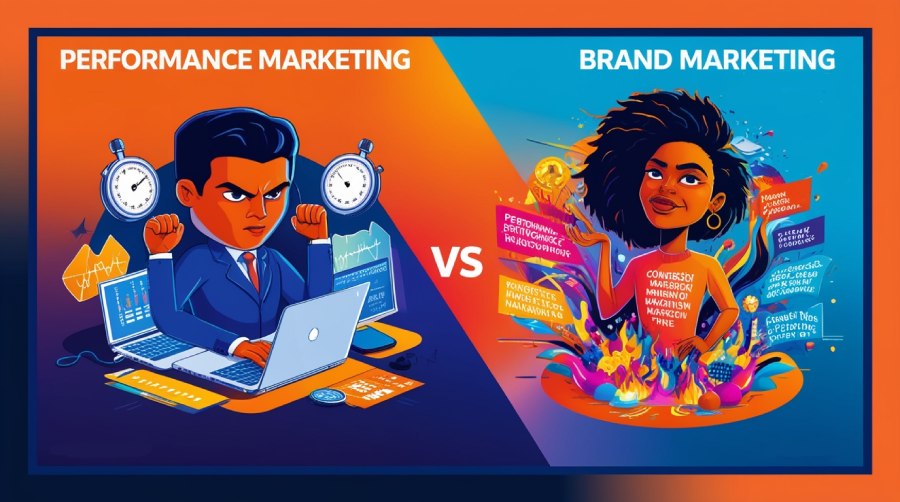
Performance Marketing vs Brand Marketing: Key Differences
In the ever-evolving landscape of digital marketing, understanding the distinction between performance marketing and brand marketing is crucial for advertisers aiming to maximize their strategies. The debate around performance vs brand marketing centers on their unique approaches, objectives, and measurement techniques. Both approaches play significant roles in the marketing ecosystem but serve different purposes and employ varied techniques. This article explores the key differences between performance and brand marketing, helping advertisers navigate these strategies effectively.
Understanding Performance Marketing
Performance marketing is a data-driven approach where advertisers pay only for measurable results, such as clicks, conversions, or sales. This type of marketing focuses on specific actions and outcomes, making it highly accountable and transparent. Advertisers can track the performance of their campaigns in real time, allowing for immediate adjustments to optimize results.
Key Characteristics
- Measurable Outcomes: Success is defined through metrics like return on ad spend (ROAS), cost per acquisition (CPA), and conversion rates.
- Data-Driven Decisions: Heavy reliance on analytics tools and performance metrics to inform strategy.
- Pay-for-Performance Model: Advertisers only pay when specific actions are completed, such as a sale or lead generation.
- Short-Term Focus: Campaigns are often designed for quick results, aiming to drive immediate action from the audience.
Channels Used in Performance Marketing
- Search Engine Marketing (SEM): Utilizing paid search ads to drive traffic and conversions.
- Social Media Advertising: Targeting specific demographics through platforms like Facebook, Instagram, and LinkedIn.
- Affiliate Marketing: Collaborating with partners who promote products and earn a commission on sales generated through their efforts.
- Programmatic Advertising: Using automated technology to buy and sell ad inventory in real time, ensuring targeted placement.
Understanding Brand Marketing
Brand marketing focuses on building and maintaining a brand's identity, awareness, and reputation over time. Unlike performance marketing, which seeks immediate results, brand marketing aims to create long-lasting relationships with consumers by fostering loyalty and recognition.
Key Characteristics
- Long-Term Vision: Emphasis on establishing brand equity and awareness that will pay off in the long run.
- Emotional Connection: Attempts to create a deeper connection with consumers through storytelling and brand values.
- Intangible Metrics: Success is measured through brand awareness, customer sentiment, and loyalty rather than direct conversions.
- Holistic Approach: Encompasses various aspects of marketing, including content marketing, public relations, and social media engagement.
Channels Used in Brand Marketing
- Content Marketing: Creating valuable content that educates or entertains the target audience, helping to establish brand authority.
- Social Media Engagement: Building relationships with consumers through regular interactions and community management.
- Public Relations: Managing the brand's image through media coverage, press releases, and crisis management.
- Television Advertising: Utilizing traditional TV ads to reach a wide audience and enhance brand recognition.
Performance vs. Brand Marketing: Key Differences
Focus and Goals
- Performance Marketing: The primary focus is on driving measurable actions, such as purchases or leads. The goal is immediate results that can be quantified.
- Brand Marketing: Focuses on creating brand awareness and fostering customer loyalty over time. The goal is to build a recognizable and trustworthy brand.
Measurement of Success
- Performance Marketing: Success is measured using quantifiable metrics like conversion rates, cost per acquisition, and return on investment (ROI).
- Brand Marketing: Metrics may include brand recognition, customer sentiment, and engagement levels, which can be harder to quantify.
Timeframe
- Performance Marketing: Campaigns are often short-term, designed to drive immediate results.
- Brand Marketing: A long-term strategy aimed at building and maintaining a brand’s reputation and awareness.
Audience Engagement
- Performance Marketing: Engages consumers with targeted messages and offers designed to provoke immediate action.
- Brand Marketing: Engages consumers on an emotional level, often through storytelling and brand values, creating a deeper connection.
Cost Structure
- Performance Marketing: Typically follows a pay-per-click or pay-per-action model, allowing advertisers to control costs based on performance.
- Brand Marketing: Involves broader spending on channels like TV and print advertising, often without direct correlation to immediate sales.
The Interplay Between Performance Marketing and Brand Marketing
While performance marketing and brand marketing have distinct characteristics, they are not mutually exclusive. In fact, the most successful marketing strategies often blend both approaches.
Integrated Strategies
- Creating Awareness with Performance Marketing: Advertisers can use performance marketing tactics to increase brand visibility and drive traffic while simultaneously gathering data on audience behavior.
- Reinforcing Brand with Performance Marketing: Once a brand has gained visibility, performance marketing can help reinforce the brand's message through targeted campaigns that emphasize its unique selling propositions (USPs).
- Using Brand Marketing for Performance Gains: Strong brand equity can lead to higher conversion rates in performance marketing efforts. When consumers have a positive perception of a brand, they are more likely to respond favorably to targeted ads.
Case Study Example: Connected TV Advertising
In the realm of connected TV (CTV) advertising, both performance and brand marketing can be effectively integrated. Advertisers can use data from CTV platforms to understand viewer preferences and behaviors, allowing them to craft targeted campaigns that drive immediate actions while also promoting brand awareness.
- Brand Building Through CTV: Long-form ads can tell a story, allowing brands to convey their values and mission while reaching a broad audience.
- Performance Tracking in CTV: Advertisers can measure the effectiveness of their campaigns through metrics like viewer engagement, click-through rates, and conversions from CTV ads.
Challenges of Performance and Brand Marketing
Performance Marketing Challenges
- Overemphasis on Short-Term Results: Focusing solely on immediate conversions can lead to neglecting the long-term brand-building aspects.
- Ad Fatigue: Continuous targeting can lead to ad fatigue, causing diminishing returns over time.
- Data Dependency: Reliance on data can sometimes lead to overlooking the creative aspects of marketing that drive emotional engagement.
Brand Marketing Challenges
- Measuring Effectiveness: Determining the ROI of brand marketing can be challenging due to its intangible nature.
- Longer Sales Cycles: Building a brand takes time, and advertisers may struggle with patience in seeing results.
- Competition for Attention: In a crowded marketplace, standing out and being memorable can be difficult.
Conclusion
Understanding the differences between performance marketing and brand marketing is essential for advertisers seeking to create effective strategies in today's digital landscape. While performance marketing focuses on measurable results and immediate actions, brand marketing aims to build lasting relationships and brand equity. By recognizing the unique strengths of each approach and how they can work together, advertisers can develop integrated campaigns that not only drive performance but also foster brand loyalty and recognition. Balancing these strategies will lead to more effective marketing in the competitive digital space.

What Do Applicants Look For in a Model Employer?








